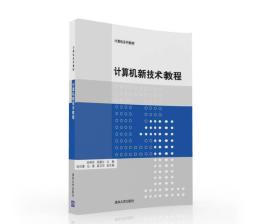
计算机新技术教程/计算机系列教材
正版二手,均有笔记不影响使用,无赠品、光盘、MP3等。如需购买套装书,请联系客服核实,批量上传数据有误差,套装书售后运费自理,还请见谅!
¥ 4.91 1.7折 ¥ 29 八五品
库存28件
作者汤晓兵、徐遵义、赵洪銮、白彧、袁卫华 著
出版社清华大学出版社
出版时间2016-07
版次1
装帧平装
货号9787302434108
上书时间2024-07-03
- 最新上架
商品详情
- 品相描述:八五品
图书标准信息
- 作者 汤晓兵、徐遵义、赵洪銮、白彧、袁卫华 著
- 出版社 清华大学出版社
- 出版时间 2016-07
- 版次 1
- ISBN 9787302434108
- 定价 29.00元
- 装帧 平装
- 开本 16开
- 纸张 胶版纸
- 页数 192页
- 字数 299千字
- 丛书 计算机系列教材
- 【内容简介】
-
本书精选和提炼了目前计算机专业领域新的研究成果和学术进展,内容取材广泛,难易适中,每单元各具特色。通过对文章中专业词汇、语法结构的介绍和分析,为读者将来在信息技术以及相关研究方向的英文资料的阅读、翻译和写作等能力提供了重要的支撑和保证。本书结合作者多年计算机教学和科研中的宝贵经验,以及与国外学术交流的体会总结,在保证本书专业知识领先的同时,更着重体现了内容的实用性和针对性。读者在提高专业英语读、写、译水平的同时,可通过本书及时地跟踪IT领域内的首屈一指的技术,把握学术上的研究热点,确立未来的学习和科研方向。
本书面向的读者是高校信息技术相关专业的本科生、大专生或是从事软、硬件开发及相关领域的工程技术人员,通过对每个单元中英文文献专题的引入、分析和解决问题的过程,培养和提高读者在专业英语方面的阅读、翻译和写作的综合能力。本书封面贴有清华大学出版社防伪标签,无标签者不得销售。
- 【目录】
-
Unit 1Hardware—Microwave Integrated Circuits/1
1.1Classification of Microwave Integrated
Circuits/1
1.2Microwave Circuits in a Communication
System/6
1.3Summary/9
1.4New Words and Expressions/10
1.5Questions/10
1.6Problems/12Unit 2Software—Microsoft Project 2013 and the Project
Management Domain/13
2.1History of Project Management/13
2.2Exploring Project Management Industry
Standards/14
2.2.1Project Management Body of Knowledge
(PMBOK)/14
2.2.2PRINCE2/18
2.3WBS, Phases and Control Points, Methodologies,
and Life Cycles/20
2.3.1Work Breakdown Structure(WBS)/20
2.3.2Managerial Control/21
2.3.3Phases and Gates/21
2.3.4Methodologies/22
2.3.5Life Cycles/22
2.4Using Microsoft Project with Methodologies and
Life Cycles/22
2.4.1Waterfall Development Process/23
2.4.2Iterative Development/23
2.4.3Research Project/27
2.5Accommodating Teaming Styles/27
2.6Consultants Tips/28
2.6.1Determine the Approach to Use in
Managing Your Project/28
2.6.2Use WBS as a First Step in Project
Definition/28
2.6.3Use the 5×9 Checklist for Planning/29
2.7New Words and Expressions/29
2.8Questions/30
2.9Problems/31Unit 3Database—NoSQL Databases: An Overview /32
3.1NoSQL: What does it mean/32
3.2Why NoSQL Databases/32
3.3Aggregate Data Models/33
3.4Distribution Models/34
3.5CAP theorem/35
3.6Types of NoSQL Databases/36
3.6.1KeyValue databases/36
3.6.2Document databases/37
3.6.3Column family stores/38
3.6.4Graph Databases/38
3.7Why choose NoSQL database/40
3.8Choosing NoSQL database/41
3.9Schemaless ramifications/41
3.10Conclusion/42
3.11New Words and Expressions/42
3.12Questions/42
3.13Problems/45Unit 4Programming—What Software Architects Need to
Know About DevOps /46
4.1What Software Architects Need to Know About
DevOps/46
4.2Defining DevOps/46
4.3DevOps Practices and Architectural Implications/48
4.4Organizational Aspects of DevOps/50
4.5Implications for Software Architecture:
Microservices/51
4.6Summary/52
4.7New Words and Expressions/53
4.8Questions/53
4.9Problems/56Unit 5Office Computing—The Ultimate Players Guide to
MinecraftXbox Edition: Gathering Resources /57
5.1Introducing the HUD/57
5.2Avoiding Getting Lost/60
5.3Improving Your Tools/61
5.4Chests: Safely Stashing Your Stuff/63
5.5Avoiding Monsters/64
5.6Hunger Management/66
5.7Your Mission: Food, Resources, and
Reconnaissance/67
5.7.1Food on the Run/68
5.7.2Finding a Building Site/70
5.8A Resourceful Guide to the Creative Mode
Inventory/72
5.9The Bottom Line/74
5.10New Words and Expressions/74
5.11Questions/75
5.12Problems/77Unit 6Networking—Troubleshooting Methods for Cisco IP
Networks/78
6.1Troubleshooting Principles/78
6.2Structured Troubleshooting Approaches/81
6.2.1The TopDown Troubleshooting
Approach/83
6.2.2The BottomUp Troubleshooting
Approach/84
6.2.3The DivideandConquer Troubleshooting
Approach/85
6.2.4The FollowthePath Troubleshooting
Approach/86
6.2.5The CompareConfigurations Troubleshooting
Approach/87
6.2.6The SwapComponents Troubleshooting
Approach/88
6.3Troubleshooting Example Using Six Different
Approaches/89
6.4Summary/91
6.5New Words and Expressions/91
6.6Questions/92
6.7Problems/94Unit 7Mobile Application—Whats Special about Mobile
Testing? /95
7.1User Expectations/96
7.2Mobility and Data Networks/97
7.3Mobile Devices/98
7.4Mobile Release Cycles/100
7.5Mobile Testing Is Software Testing/101
7.6Summary/102
7.7New Words and Expressions/102
7.8Questions/103
7.9Problems/105Unit 8Web Development—The Mobile Commerce Revolution
and the Current State of Mobile/106
8.1Americans and Smartphones/106
8.2Mobile Around the World/109
8.3Mobile Commerce/110
8.4Beyond the Numbers/110
8.5The Bottom Line/113
8.6New Words and Expressions/113
8.7Questions/114
8.8Problems/116Unit 9Security—Information Security Principles of
Success/117
9.1Introduction/117
9.2Principle 1: There Is No Such Thing As Absolute
Security/117
9.3Principle 2: The Three Security Goals Are
Confidentiality, Integrity, and Availability/119
9.3.1Integrity Models/119
9.3.2Availability Models/120
9.4Principle 3: Defense in Depth as Strategy/120
9.5Principle 4: When Left on Their Own, People
Tend to Make the Worst Security Decisions/122
9.6Principle 5: Computer Security Depends on Two
Types of Requirements: Functional and
Assurance/122
9.7Principle 6: Security Through Obscurity Is Not
an Answer/123
9.8Principle 7: Security = Risk Management/124
9.9Principle 8: The Three Types of Security
Controls Are Preventative, Detective, and
Responsive/126
9.10Principle 9: Complexity Is the Enemy of
Security/127
9.11Principle 10: Fear, Uncertainty, and Doubt Do
Not Work in Selling Security/127
9.12Principle 11: People, Process, and Technology
Are All Needed to Adequately Secure a System
or Facility/127
9.13Principle 12: Open Disclosure of Vulnerabilities
Is Good for Security!/128
9.14Summary/129
9.15New Words and Expressions/129
9.16Questions/130
9.17Problems/131Unit 10Web Services—Designing Software in a Distributed
World/132
10.1Visibility at Scale/133
10.2The Importance of Simplicity/134
10.3Composition/134
10.3.1Load Balancer with Multiple Backend
Replicas/134
10.3.2Server with Multiple Backends/136
10.3.3Server Tree/138
10.4Distributed State/139
10.5The CAP Principle/142
10.5.1Consistency/142
10.5.2Availability/143
10.5.3Partition Tolerance/143
10.6Loosely Coupled Systems/145
10.7Speed/147
10.8Summary/150
10.9New Words and Expressions/151
10.10Questions/151
10.11Problems/153Unit 11Big Data—Big Data Computing/154
11.1Introduction/154
11.2Apache Hadoop Data modelling/156
11.3NoSQL Big Data systems/157
11.3.1Key Value stores/157
11.3.2Document databases/157
11.3.3Graph databases/158
11.3.4XML databases/158
11.3.5Distributed Peer Stores/158
11.3.6Object stores/159
11.4Definitions of Data Management /159
11.4.1Data management/159
11.4.2Big data management (BDM)/160
11.5The State of Big Data Management/160
11.6Big Data Tools/162
11.6.1Big data tools: Jaspersoft BI Suite/162
11.6.2Big data tools: Pentaho Business
Analytics/163
11.6.3Big data tools: Karmasphere Studio and
Analyst/163
11.6.4Big data tools: Talend Open Studio/164
11.6.5Big data tools: Skytree Server/164
11.6.6Big data tools: Tableau Desktop and
Server/165
11.6.7Big data tools: Splunk/165
11.7New Words and Expressions/166
11.8Questions/166
11.9Problems/168Unit 12Cloud Computing—The Practice of Cloud
System Administration: Operations in a
Distributed World/169
12.1Distributed Systems Operations/170
12.1.1SRE versus Traditional Enterprise
IT/170
12.1.2Change versus Stability/171
12.1.3Defining SRE/173
12.1.4Operations at Scale/174
12.2Service Life Cycle/177
12.2.1Service Launches/178
12.2.2Service Decommissioning/180
12.3Organizing Strategy for Operational Teams/180
12.3.1Team Member Day Types/183
12.3.2Other Strategies/185
12.4Virtual Office/186
12.4.1Communication Mechanisms/187
12.4.2Communication Policies/187
12.5Summary/188
12.6New Words and Expressions/189
12.7Questions/190
12.8Problems/191Answers to Questions/193References/194
— 没有更多了 —












以下为对购买帮助不大的评价